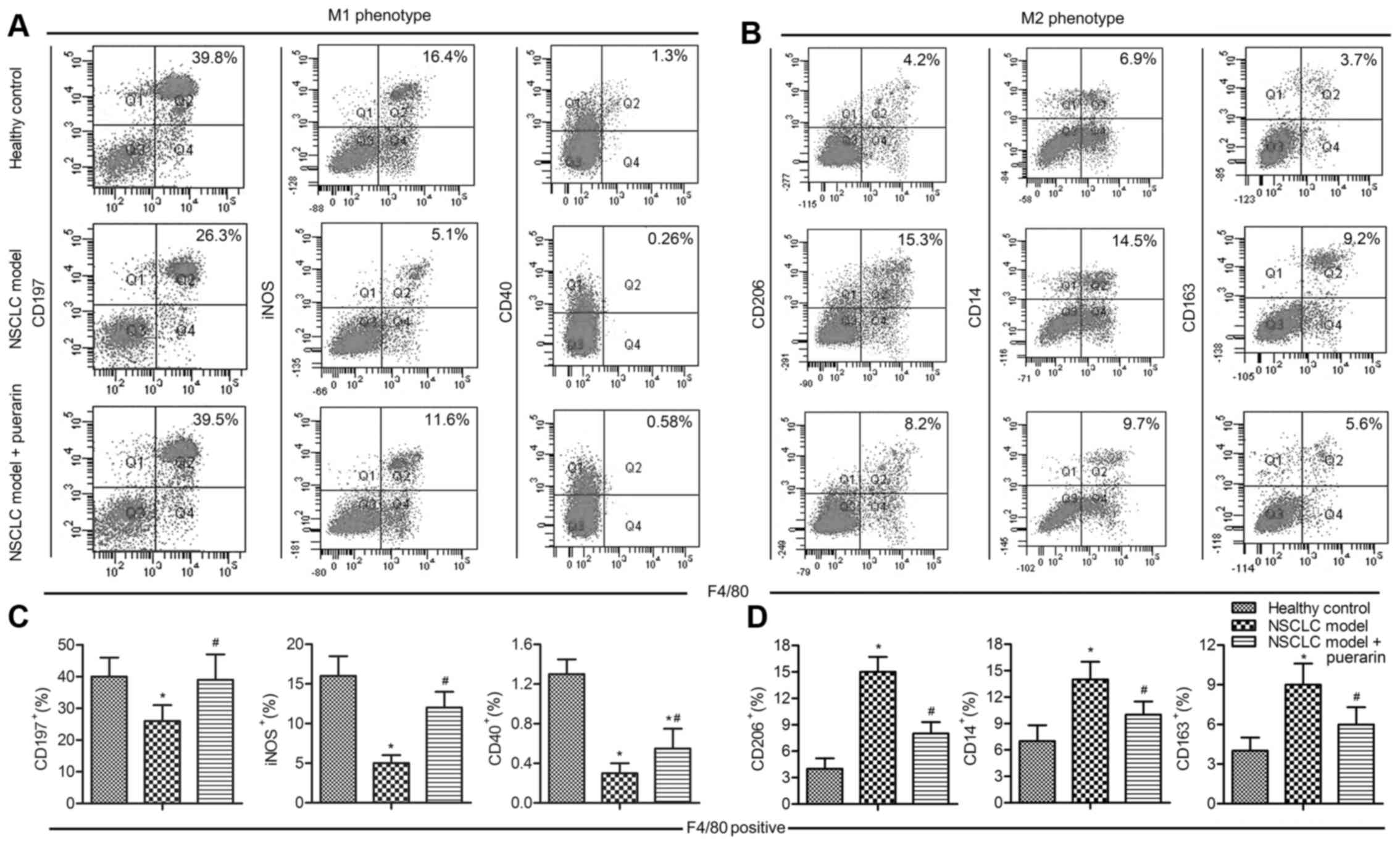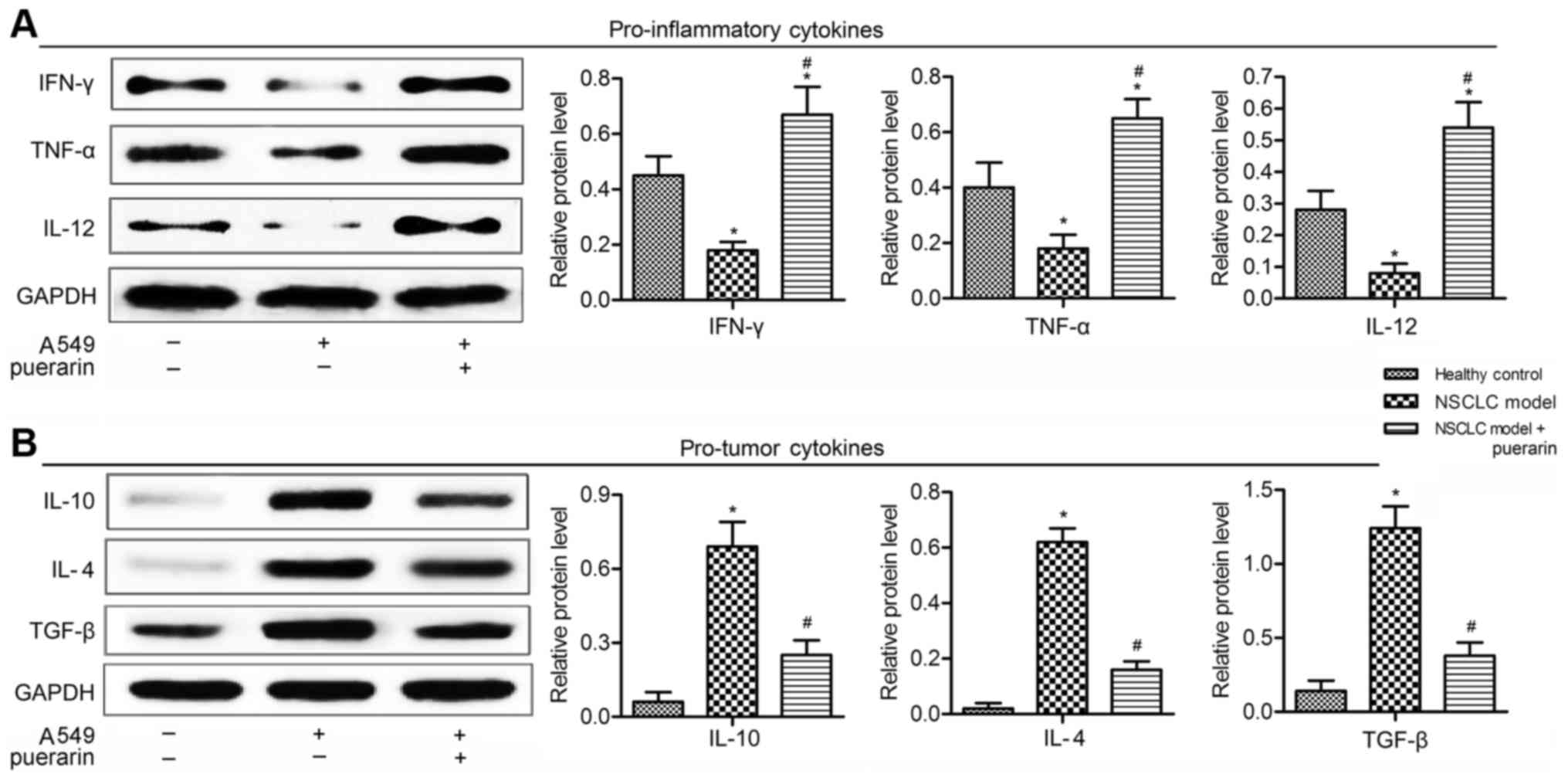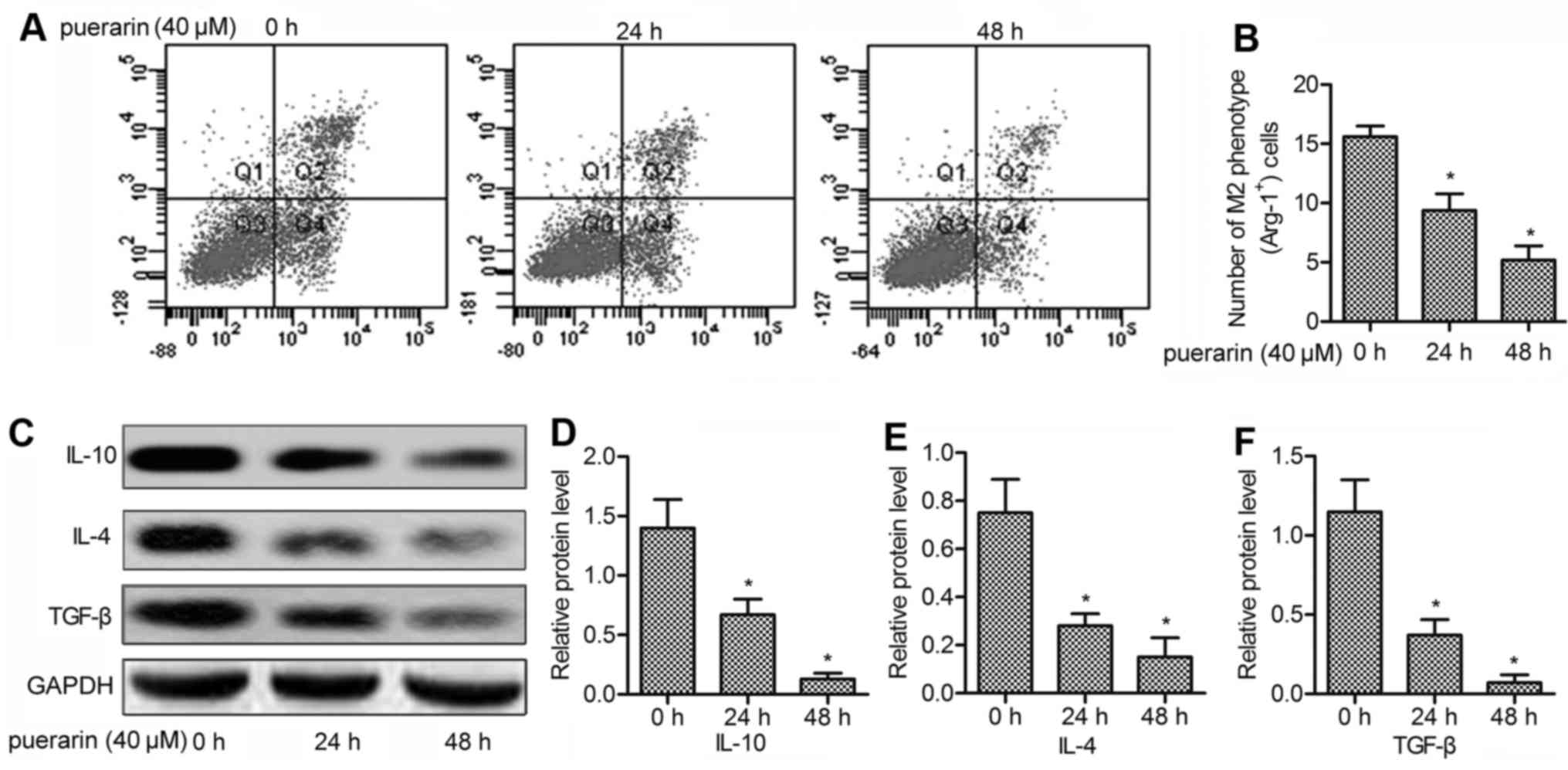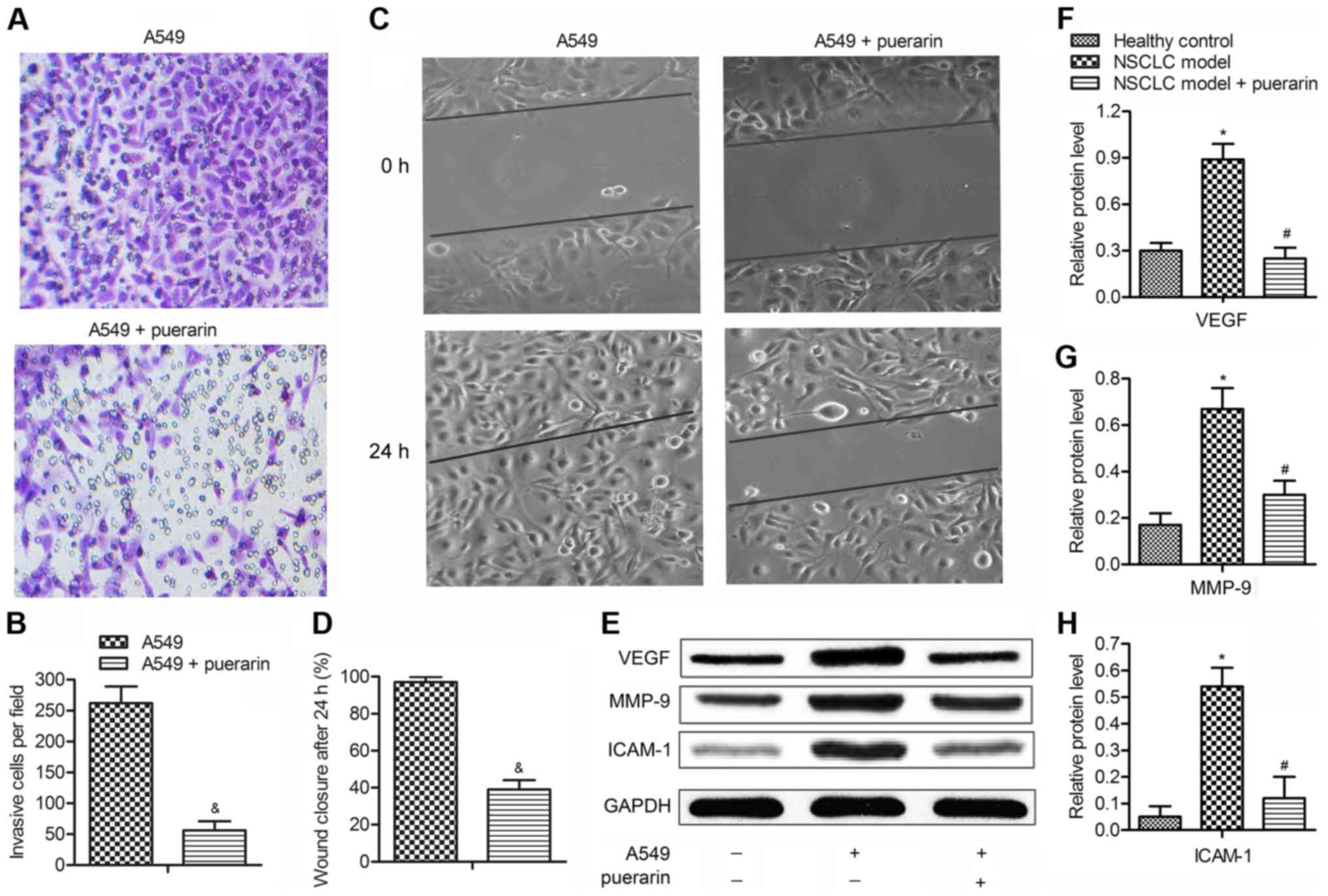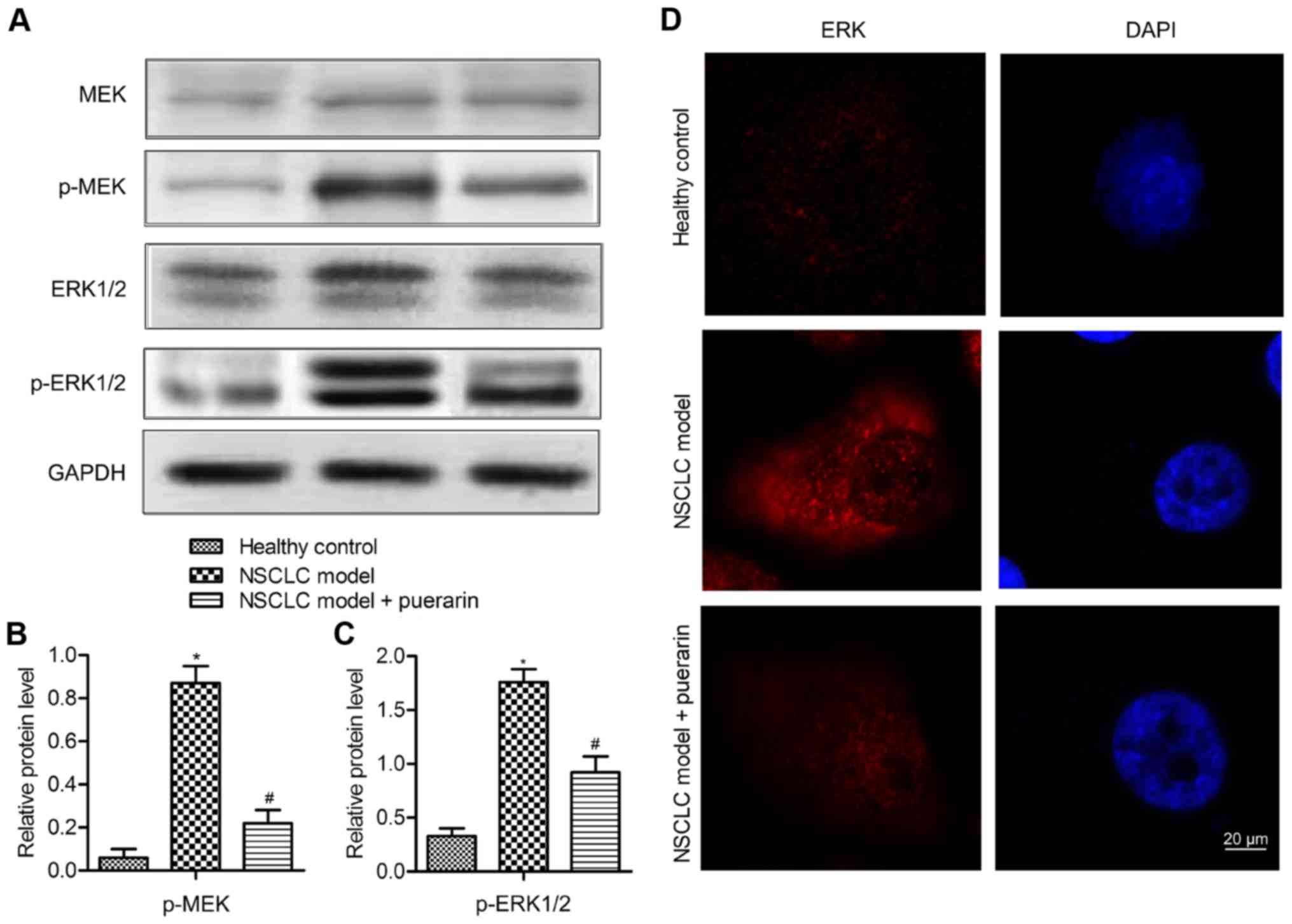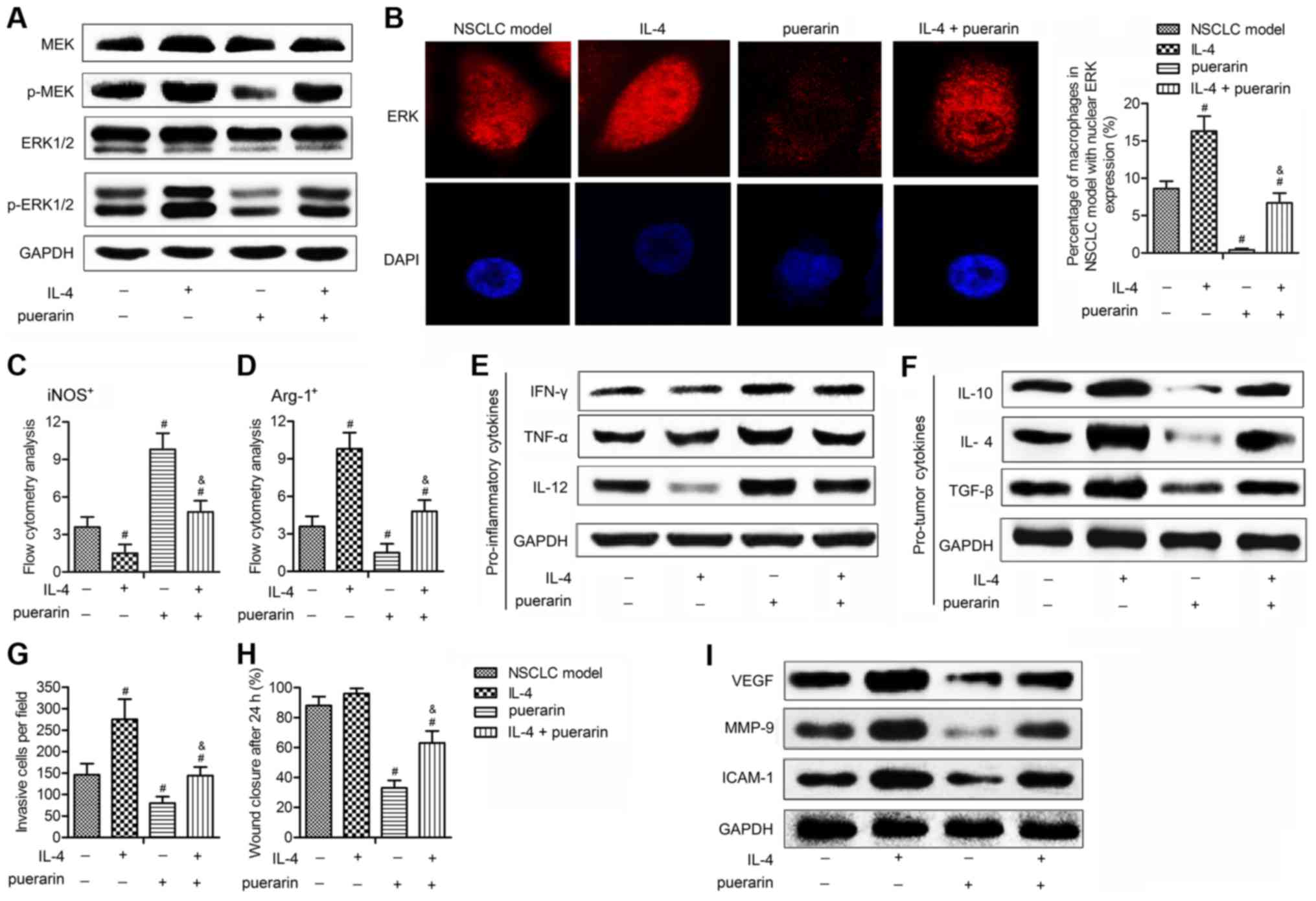Puerarin inhibits M2 polarization and metastasis of tumor-associated macrophages from NSCLC xenograft model via inactivating MEK/ERK 1/2 pathway
- Authors:
- Published online on: January 5, 2017 https://doi.org/10.3892/ijo.2017.3841
- Pages: 545-554
Abstract
Introduction
Non-small cell lung carcinoma (NSCLC) is a leading cause of cancer death worldwide, and represents close to 90% of all lung cancers with a poor prognosis. The progression of lung cancer is a complex and multistep process where several mechanisms such as transformation, hypoxia, invasion, migration and metastasis are known to be the main hallmarks, especially metastasis, which is responsible for 90% of cancer-related mortality (1). Clinical data have shown that most lung cancer patients eventually suffer relapse and/or metastasis after complete excision of the cancer, even if they were at stage I-A (2). Research on NSCLC metastasis has recently expanded to tumor-microenvironment, which include the stromal cellular compartment and extra-cellular matrix components. Metastasis (from initial angiogenesis, intravasation, to extravasate into a distant tissue) is an inefficient process and few released cancer cells complete the entire process, micro-environmental interactions assist each of these steps (3). It is necessary to better understand the mechanisms by which tumor cells co-operate with the micro-environment.
Together with other immune cells, tumor cells and interstitial cytokines, the tumor associated macrophages (TAMs) can be brought to form a tumor immune microenvironment (4). TAMs refer to a kind of macrophages which are migrated and infiltrated in local tumor during the occurrence and development of tumors (5). TAMs are known to be crucial cells in lung cancer as they are in close proximity to tumor cells compared to other stromal cells (1). According to the activation type of macrophage, it can be divided into two main types M1 and M2. It is generally considered that these two types of macrophages are antagonistic (6,7). M1 phenotype is activated by interferon (IFN)-γ, LPS and tumor necrosis factor (TNF)-α (8,9). This phenotype is associated with the expression of interleukin (IL)-12, TNF-α and inducible nitric oxide synthase (iNOS)(10,11) and also with extended survival time in NSCLC patients (12). M2 phenotype possesses effects of inflammation inhibition by producing anti-inflammatory cytokines such as IL-4 and IL-10 (7,11,13). This phenotype can promote tumor growth and sustain tumor survival (14). They also play a vital role in increasing angiogenesis via VEGF, which is a prominent mediator of angiogenesis (15). Given the above, the inducing of M1 and inhibition of M2 polarization may help alleviate the metastasis of NSCLC.
Puerarin [4H-1-benzopyran-4-one,8-β-D-glucopyranosyl-7-hydroxy-3-(4-hydroxyphenyl), C21H20O9] is the major bioactive ingredient isolated from the root of traditional Chinese medicine Ge-gen (Radix Puerariae, RP) (16). Due to its wide spectrum of pharmacological properties (e.g., cardioprotection, neuroprotection, antioxidant, anticancer, alleviating pain and inhibiting alcohol intake), puerarin has been widely used in the treatment of various deseases, including cardiovascular, diabetes, Parkinson's disease, endometriosis and cancer (17). The antitumor activity of puerarin has been reported on human lung carcinoma A549 cell line (18). However, the effect of puerarin on NSCLC metastasis has rarely been reported.
The present study applied puerarin in the context of NSCLC, we found that puerarin reduced the tumor growth in NSCLC xenograft model. Besides, puerarin acted directly on macrophages to inhibit macrophage polarized to M2 phenotype and suppressed cell invasion and migration. These inhibition effects may function through inactivating MEK/ERK 1/2 pathway. Taken together, our results suggest that puerarin may provide novel insight into the mechanism and treatment of NSCLC.
Materials and methods
NSCLC xenografts
All the animals involved in the present study were purchased from the the Institute of Zoology, Chinese Academy of Medical Sciences (NOD/SCID mice, clean, 8-week-old and weighing 20–22 g). Human NSCLC cells A549, obtained from the American Type Culture Collection (ATCC; Manassas, VA, USA), were digested by the pancreatic enzymes and the final concentration was adjusted to 1×106/ml. On day 0, the mice (n=50) were narcotized with 200 l of 0.75% sodium pentobarbital solution per mouse and the subcutaneous injection were conducted of 5×106 A549 cells. The mice in the treatment group (n=25) were injected with puerarin (40 mg/kg body weight) every other day, while the mice (n=25) in model group received the same volume injection of phosphate-buffered saline (PBS). After the development of a palpable tumor, the tumor volume was monitored every 6 days, briefly, tumor was isolated from five mice in each group, the volume was assessed by the following formula: tumor volume (mm3) = maximal length (mm) × perpendicular width (mm)2/2. All mice were assigned to euthanasia at the end of the measurements. On day 30, tumor tissues in model mice and puerarin treating mice were collected. All animal experiments were performed according to the current guidelines and under a protocol approved by the Institutional Animal Care and Use Committee.
Flow cytometry
Macrophages from local tumor tissue in model mice were considered as NSCLC model group; macrophages from lung tissues in healthy mice were considered as healthy control group; macrophages from the tumor tissue in puerarin treating mice were regarded as NSCLC model + puerarin group. The suspensions of macrophages from each group were prepared by grinding the organ through a 40-mm nylon mesh in medium. For cell surface staining, cells were stained for 20 min at room temperature (RT) in 1% BSA-PBS buffer with the following panel of antibodies: Alexa Fluor 488-anti-F4/80 (Serotec, Oxford, UK) and PE-CD197, PE-iNOS, PE-CD40, PE-CD206, PE-Arg-1 and PE-CD163 (eBioscience, San Diego, CA, USA), followed by flow cytometry (BD Biosciences, San Jose, CA, USA). Data were analyzed using CellQuest software.
Western blotting
Macrophages were lysed in lysis buffer (Beyotime Institute of Biotechnology, Haimen, China) supplemented with 1 mM phenylmethanesulfonyl fluoride (PMSF). The protein concentration was determined using the BCA protein assay (Tiangen Biotech, Co., Ltd., Beijing, China). Twenty micrograms of protein in each sample was separated by 12% SDS-PAGE and electro-transferred to polyvinylidene fluoride (PVDF) membranes (Millipore, Billerica, MA, USA) for immunoblotting. The following primary antibodies were used: anti-IFN-γ (1:1,000, ab175878; Abcam), anti-TNF-α (1:1,000, ab6671; Abcam), anti-IL-12 (1:500, ab9992; Abcam), anti-IL-10 (1:500, ab34843; Abcam), anti-IL-1β (Santa Cruz Biotechnology, Santa Cruz, CA, USA), anti-TGF-β (1:500, ab66043; Abcam), anti-VEGF (1:1,000, ab32152; Abcam), anti-MMP-9 (1:100, ab73734; Abcam), anti-ICAM-1 (1:20, ab20; Abcam), anti-MEK (1:20,000, ab178876; Abcam), anti-p-MEK (1:500, ab194754; Abcam), anti-ERK1/2 (1:100, ab54230; Abcam), anti-p-ERK1/2 (Santa Cruz Biotechnology) and anti-GAPDH (1:500, ab8245; Abcam), which was used as the internal reference. After incubation with the appropriate horseradish peroxidase (HRP)-conjugated secondary antibody, proteins were detected using a ChemiDoc XRS imaging system and Quantity One analysis software (Bio-Rad Laboratories, San Francisco, CA, USA).
Preparation of purified macrophages
Macrophages were prepared as previously reported (19). Macrophages from tumor tissue in model mice were seeded in 6-well tissue culture plates (2×106 cells/ml; Corning, Inc., Corning, NY, USA) and allowed to adhere for 1 h. Adherent cells were purified by positive selection using CD68 MicroBeads (Miltenyi Biotec, Leiden, The Netherlands). The purity of CD68+ cells was evaluated by flow cytometry (CD68+F4/80+ cells >96%). The purified macrophages were incubated with puerarin (40 µM) for 48 h. The number of M2 phenotype (Arg-1+) was measured by flow cytometry. The level of M2 cytokines (IL-10, IL-4 and TGF-β) was detected by western blot analysis.
Transwell invasion assay
Transwell membranes coated with Matrigel (Becton-Dickinson, Franklin Lakes, NJ, USA) were used to assay invasion of NSCLC cells in vitro. A549 cells pretreated with or without puerarin (40 µM) for 24 h were plated at 2×104/well in the upper chamber in serum-free medium, 20% fetal bovine serum (FBS) was added to the medium in the lower chamber. After incubating for 24 h, non-invading cells were removed from the top well with a cotton swab, while the bottom cells were fixed in 95% ethanol, stained with hematoxylin. The cell numbers were determined by counting the penetrating cells under a microscope at ×200 magnification on 10 random fields in each well. Each experiment was performed in triplicate.
Wound healing assay
The CytoSelect 24-Well Wound Healing assay (Cell Biolabs, Inc., San Diego, CA, USA) was used to analyze the migration of NSCLC cells. The assay was performed according to the manufacturer's recommendations using 2×103 A549 cells pre-treated with or without puerarin (40 µM) for 24 h/well. Image acquisition of wound fields was done after the removal of inserts (0 h) and wound closure documentation was completed after 24 h with a phase-contrast microscope (Leica DM IL; Leica Microsystems, Wetzlar, Germany) equipped with a digital camera (Leica DFC300 FX). Image analysis was conducted with Adobe Photoshop CS7 software.
Immunofluorescence staining
Purified macrophages (2×103 cells/well) were cultured on 8-well chamber CultureSlides (Becton-Dickinson, Bedford, MA, USA). After 8 h, cells were fixed in 3% paraformaldehyde in PBS at room temperature for 8 min, then permeabilized with 0.2% Triton X-100 for 15 min at room temperature. After washing in PBS, the cells were incubated with primary mouse anti-ERK monoclonal antibody (1 mg/ml; Transduction Laboratories, Lexington, KY, USA) at 4°C overnight. After washing, cells were incubated with biotinylated goat anti-mouse IgG (Pierce, Rockford, IL, USA) at room temperature for 1 h. The immunoreactivity was revealed using Alexa568-conjugated streptavidin (Molecular Probes, Eugene, OR, USA) and cells were counterstained with 10 mg/ml DAPI. The cells were examined under a Nikon fluorescence microscope (Image Systems, Columbia, MD, USA).
Statistical analysis
All results are presented as mean ± SD from a minimum of three replicates. Differences between the groups were evaluated by the SPSS version 15.0 statistical software with the Student's t-test when comparing only two groups or assessed by one-way ANOVA when more than two groups were compared. Differences were considered statistically significant at P<0.05.
Results
Puerarin reduces tumor growth of NSCLC xenograft model
NSCLC xenograft model was established by subcutaneous injection of A549 cells into NOD/SCID mice. The representative images of NSCLC xenograft model and isolated tumors are shown in Fig. 1A and B. The tumor growth was slower in puerarin group compared with model group, and the tumor volumes were reduced significantly in NSCLC mice under treatment with puerarin (P<0.05; Fig. 1C). The results displayed the antitumor effect of puerarin in the NSCLC xenograft model.
Puerarin inhibits macrophages polarized to M2 phenotype
TAMs are abundant components of NSCLC, the polarization status (M1/M2) has pro-inflammatory or pro-tumoral properties (20). We next explored whether the antitumor role of puerarin was involved in regulating macrophage polarization. The proportions of M1 markers (CD197+, iNOS+ and CD40+) and M2 markers (CD206+, Arg-1+ and CD163+) were detectd by flow cytometry. The results showed that M1 markers were decreased in model group compared with the control group (P<0.05), and the treatment with puerarin in NSCLC model elevated M1 markers (P<0.05; Fig. 2A and C). On the contrary, M2 markers (CD206+, Arg-1+ and CD163+) were increased in model group compared with the control group (P<0.05), but strongly decreased adding puerarin in NSCLC model (P<0.05; Fig. 2B and D). These results suggested that puerarin exert antitumor effect via inhibiting macrophage polarized to M2 phenotype.
Puerarin increases pro-inflammatory cytokines and decreases pro-tumor cytokines
Polarized macrophages differ in terms of effector function, cytokine and chemokine production (21). Here, the expression level of cytokines in NSCLC xenograft model was detected by western blot analysis. Levels of pro-inflammatory cytokines (IFN-γ, TNF-α and IL-12) were decreased in model group compared with the control group (P<0.05), but were promoted in puerarin group compared to the model group (P<0.05; Fig. 3A). The expression of tumorigenesis-related cytokines (IL-10, IL-4 and TGF-β) was elevated in model group in comparison with the control group (P<0.05), but the levels were significantly reduced in NSCLC model treated with puerarin (P<0.05; Fig. 3B). These results indicated puerarin exhibited antitumor effect by inflammatory cytokines and decreased tumorigenesis-related cytokines.
Puerarin acts directly on macrophages to inhibit M2 polarization
To explore whether puerarin directly acts on macrophages, we purified macrophages from model mice. An in vitro experiment was conducted to investigate the role of puerarin on M2 polarization. The results showed that the number of M2 phenotype (Arg-1+) was significantly reduced under treatment with puerarin for 24 h (P<0.05; Fig. 4A), and the number was further decreased after 48 h (P<0.05; Fig. 4B). To confirm the inhibitory effect of puerarin on M2 polarization, the level of M2 cytokines (IL-10, IL-4 and TGF-β) was detected by western blot analysis. The results displayed that the expression of IL-10, IL-4 and TGF-β was strongly inhibited adding puerarin for 24 and 48 h (P<0.05; Fig. 4C–F). Taken together, our results clearly demonstrated that puerarin inhibited macrophages polarized to M2 phenotype and did not require the participation or the auxiliary of other cells.
Puerarin suppresses the invasion and migration of NSCLC cells
A report indicated that high density of M2 macrophages is associated with the metastasis in NSCLC patients (22). The effect of puerarin on the motility of NSCLC cells (A549) was measured by Transwell assays and scratch assays. The number of invasive cells was decreased by 2.5 times adding puerarin (40 µM) in A549 cells (P<0.05; Fig. 5A and B). The results of scratch assays agreed with the Transwell assays. The A549 group showed a complete closure of the gap, whereas puerarin increased the gap by ~50% compared with model group (P<0.05; Fig. 5C and D). These observations suggested that puerarin was a negative metastatic regulator of NSCLC. The expression of tumor metastasis-related proteins (VEGF, MMP-9 and ICAM-1) were then determined by western blot analysis (Fig. 5E). The results indicated that the levels of the three proteins were increased in model group compared with the control group (P<0.05), but puerarin significantly restrained their expression compared with the model group (P<0.05; Fig. 5F–H). The suppression of puerarin on migration-related protein expressions further confirming the inhibition effect of puerarin on the metastasis of NSCLC.
Puerarin restrains the activation of MEK/ERK1/2 pathway
To investigate the mechanism of puerarin on the metastasis of NSCLC, the level of MEK, ERK1/2 and their phosphorylated forms was measured by western blot analysis (Fig. 6A). The results displayed that the expression of p-MEK and p-ERK 1/2 was enhanced in model group compared with the control group (P<0.05), indicating that the MEK/ERK 1/2 pathway was activated in the NSCLC model. But the level of p-MEK and p-ERK 1/2 was reduced significantly in NSCLC model treated with puerarin (P<0.05) (Fig. 6B and C). To verify the inactivating role of puerarin, the subcellular localization of ERK was measured. Cells in the control group showed membrane ERK staining with minimal cytoplasmic or nuclear staining, the model group displayed predominantly nuclear ERK staining. However, the cells in the puerarin group displayed reduced cytoplasmic and nuclear staining of ERK as compared with the model group (Fig. 6D). These results indicated that puerarin restrained the activation of MEK/ERK 1/2 pathway through inhibition of the ERK nucleus translocation.
IL-4-induced M2 macrophage polarization and metastasis are partially offset by puerarin through MEK/ERK1/2 pathway
To convince that puerarin exerts antitumor effect on NSCLC is through inactivating MEK/ERK 1/2 pathway, we applied IL-4, which has been reported to mediate M2 macrophage polarization and promote tumor metastases via activating ERK pathway (23,24). As shown in Fig. 7A and B, IL-4 upregulated the level of p-MEK and p-ERK 1/2, and a large accumulation of ERK staining in cytoplasm and nucleus was detected in NSCLC model induced by IL-4, indicating the strong activation of MEK/ERK 1/2 pathway. However, the expression of p-MEK and p-ERK 1/2 and the percentage of cells with nucleus ERK expression was significantly inhibited adding puerarin in IL-4-induced NSCLC model. These findings convinced the inhibitory effect of puerarin on MEK/ERK 1/2 pathway. Besides, puerarin increased iNOS+ macrophages (Fig. 7C), which were reduced by IL-4, whereas the elevated Arg-1+ macrophages induced by IL-4 were down-regulated by puerarin (Fig. 7D). Consistently, IL-4 reduced pro-inflammatory markers (IFN-γ, TNF-α and IL-12) (Fig. 7E) and increased pro-tumor markers (IL-10, IL-4 and TGF-β) (Fig. 7F), these effects were offset adding puerarin in IL-4 induced NSCLC model. Besides, the promoting effect of IL-4 on metastasis was restrained by puerarin (Fig. 7G). In addition, puerarin reduced the invasive numbers, slowing the wound healing (Fig. 7H) and inhibited expression of tumor metastasis-related proteins (VEGF, MMP-9 and ICAM-1) (Fig. 7I). Taken together, these results are convincing that puerarin suppressed M2 macrophage polarization and metastasis of NSCLC via inactivating MEK/ERK 1/2 pathway.
Discussion
Although early-stage non-small cell lung cancer (NSCLC) can be cured by surgical resection, a substantial fraction of patients ultimately dies due to distant metastasis (25). Therefore, identifying novel molecules that can repress the invasiveness and metastasis of NSCLC will facilitate the development of new anti-lung cancer strategies (26). As a well known isoflavone C-glycoside, puerarin is available in common foods and has been shown to possess beneficial effects for various patients (17). The present study examined the effect of puerarin on macrophage polarization and metastasis of NSCLC.
Accumulated studies have demonstrated anticancer activity of puerarin in animal models as well as in a variety of cancer cell lines. Puerarin was suggested as a safe and effective chemosensitive agent in the treatment of human esophageal cancer, for puerarin inhibited proliferation of Eca-109 esophageal cancer cells in vitro and in vivo, and did not increase the side-effects of chemotherapy (27). The same behavior of puerarin was observed in gastric carcinoma (28), hepatocellular carcinoma (29) and colon cancer (30). Recently, an in vitro and in vivo animal study showed that puerarin significantly inhibited tumor growth in A549 cells (18). Consistently, our research exhibited that puerarin suppressed tumor growth and tumor volumes in NSCLC xenograft model, suggesting the antitumor effect of puerarin in NSCLC.
The TAMs can secrete a variety of cytokines, which play a key role in the formation of tumor microenvironment and tumor invasion and metastasis (31). The function of M1 and M2 macrophages is entirely different in the tumor microenvironment (6). To investigate the effect of puerarin on M1 and M2 marker expression in TAM populations, we selected M1 markers (e.g., CD197 and iNOS) and M2 markers (e.g., CD206 and Arg-1), based on a large amount of literature in the relevant field of macrophage polarization (6,7,32,33). iNOS was suggested as an important mediator that may alter the TAM phenotype and eventually improve tumor suppressing function (34). TAMs that express iNOS were associated with extended survival in patients with NSCLC (12). A report indicated that iNOS expression was decreased in tissue from NSCLC patients with adenocarcinoma and squamous cell carcinoma compared to non-tumor tissues (7). A previous study measured reduced iNOS expression in TAMs that were directly isolated from the tumor in tumor-bearing mice (35). In accordance with these reports, our research demonstrated that M1 macrophages (CD197+, iNOS+ and CD40+) were decreased in NSCLC model, while puerarin strongly increased M1 macrophages. These results indicated that puerarin may alter the TAM phenotype through upregulating M1 macrophages. The expression of the M2 marker in TAMs was significantly correlated to poor prognosis and lymph node metastasis in patients with advanced adenocarcinoma (14). A report exhibited that the expression of M2 marker CD163 was significantly increased in all NSCLC subtypes (7) and in patients with progressive disease (36). Similarly, the M2 markers (CD206+, Arg-1+ and CD163+) were increased in NSCLC model in the present study. However, puerarin strongly decreased the expression of M2 markers. Considering the percentage of TAMs within a tumor microenvironment has been linked with tumor metastasis (14). Our results suggested the anti-metastasis effect of puerarin is through elevating M1 markers and inhibiting M2 markers.
The presence of cytokines is essential for the initiation of immune responses (37). Th1 cells have been found to play a major role in anti-tumor immunity, whereas Th2 cells are known to act as the helper cells that influence B-cell development and produce anti-inflammatory cytokines (38). Pro-inflammatory cytokines such as TNF-α and IFN-γ are known to stimulate Th1 cells (19,39). In contrast, Th2 cells produce anti-inflammatory cytokines such as IL-4 and IL-10 (13,24). TGF-β has been suggested to induce an M2-like phenotype characterized by upregulation of the anti-inflammatory cytokine IL-10 and downregulation of the pro-inflammatory cytokines TNF-α and IL-12 (40). IL-10 itself can also promote M1 to M2 transition (41). In this study, puerarin enhanced the expression of antitumor cytokines (IFN-γ, TNF-α and IL-12), reduced the level of anti-inflammatory cytokines (IL-10, IL-4 and TGF-β). The following in vitro experiments showed that puerarin significantly reduced Arg-1+ macrophages and the level of M2 markers. These results indicated that puerarin was able to skew macrophage populations back to M1 subsets to stimulate antitumor effects within the tumor microenvironment, by directly acting on macrophages.
Puerarin can inhibit the adhesion, invasion and migration of HO-8910 cells, plays an antagonist effect against the stimulation of estrogen on the malignant behavior of tumor cells (42). A report also indicated that puerarin suppressed the tissue invasion and the vascularization of ectopic endometrial tissues stimulated by 17β-estradiol, by decreasing the angiogenesis factors MMP-9, ICAM-1 and VEGF (43). Based on the research, puerarin suppressed the invasion and migration of A549 cells, inhibited the expressions of tumor metastasis-related proteins (VEGF, MMP-9 and ICAM-1) in macrophages. These results confirmed that puerarin was a negative metastatic regulator of NSCLC.
The activation of MEK/ERK 1/2 pathway is closely related to NSCLC metastasis. A report indicated that the activation of ERK signaling skewing macrophage polarization away from the M1- to a tumor-promoting M2-like phenotype, and high density of M2 macrophages was associated with metastasis in NSCLC patients (22). Previous research also demonstrated that suppressing ERK1/2 led to suppression of various critical proteins for A549 invasion and migration (44). The results in this study indicated that puerarin restrained the activation of MEK/ERK 1/2 pathway through inhibition of ERK nucleus translocation. Besides, IL-4-induced M2 macrophage polarization and metastasis were partially offset by puerarin through restraining MEK/ERK 1/2 pathway. These results are convincing that puerarin suppressed M2 macrophage polarization and metastasis of NSCLC via inactivating the MEK/ERK 1/2 pathway.
In conclusion, the present study explored puerarin on macrophage polarization and metastasis of NSCLC. We found that puerarin suppressed tumor growth in NSCLC xenograft model, increased M1 macrophages, decreased M2 markers, enhanced the expression of antitumor cytokines, reduced the level of pro-tumor cytokines. Besides, puerarin suppressesed the invasion and migration of NSCLC macrophages, inhibited the expressions of angiogenesis factors. Finally, IL-4-induced M2 macrophage polarization and metastasis were partially offset by puerarin through restraining MEK/ERK 1/2 pathway. These results validated that puerarin is able to skew macrophage populations back to M1 subsets to stimulate anti-tumor effects, and suggest puerarin is a negative metastatic regulator of NSCLC.
Abbreviations:
|
NSCLC |
non-small cell lung carcinoma |
|
TAMs |
tumor associated macrophages |
|
iNOS |
inducible nitric oxide synthase |
|
IFN-γ |
interferon-γ |
|
TNF-α |
tumor necrosis factor-α |
|
IL |
interleukine |
|
TGF-β |
transforming growth factor-β |
|
VEGF |
vascular endothelial growth factor |
|
MMP-9 |
matrix metalloproteinase-9 |
|
ICAM-1 |
intercellular adhesion molecule-1 |
|
MEK |
mitogen-activated extracellular signal-regulated kinase |
|
ERK |
extracellular signal-regulated kinase |
Acknowledgments
All authors would like to thank the members of the Liaocheng People's Hospital, for providing helpful discussions and technical support concerning the present study.
References
|
Kim R, Emi M, Tanabe K and Arihiro K: Tumor-driven evolution of immunosuppressive networks during malignant progression. Cancer Res. 66:5527–5536. 2006. View Article : Google Scholar : PubMed/NCBI | |
|
Harpole DH Jr: Prognostic modeling in early stage lung cancer: An evolving process from histopathology to genomics. Thorac Surg Clin. 17:167–173. viii2007. View Article : Google Scholar : PubMed/NCBI | |
|
Wood SL, Pernemalm M, Crosbie PA and Whetton AD: The role of the tumor-microenvironment in lung cancer-metastasis and its relationship to potential therapeutic targets. Cancer Treat Rev. 40:558–566. 2014. View Article : Google Scholar | |
|
Rhee I: Diverse macrophages polarization in tumor microenvironment. Arch Pharm Res. 39:1588–1596. 2016. View Article : Google Scholar : PubMed/NCBI | |
|
Shigeoka M, Urakawa N, Nishio M, Takase N, Utsunomiya S, Akiyama H, Kakeji Y, Komori T, Koma Y and Yokozaki H: Cyr61 promotes CD204 expression and the migration of macrophages via MEK/ERK pathway in esophageal squamous cell carcinoma. Cancer Med. 4:437–446. 2015. View Article : Google Scholar : PubMed/NCBI | |
|
Liu B, Wang X, Chen TZ, Li GL, Tan CC, Chen Y and Duan SQ: Polarization of M1 tumor associated macrophage promoted by the activation of TLR3 signal pathway. Asian Pac J Trop Med. 9:484–488. 2016. View Article : Google Scholar : PubMed/NCBI | |
|
Almatroodi SA, McDonald CF, Darby IA and Pouniotis DS: Characterization of M1/M2 tumour-associated macrophages (TAMs) and Th1/Th2 cytokine profiles in patients with NSCLC. Cancer Microenviron. 9:1–11. 2016. View Article : Google Scholar : | |
|
Ferrante CJ, Pinhal-Enfield G, Elson G, Cronstein BN, Hasko G, Outram S and Leibovich SJ: The adenosine-dependent angiogenic switch of macrophages to an M2-like phenotype is independent of interleukin-4 receptor alpha (IL-4Rα) signaling. Inflammation. 36:921–931. 2013. View Article : Google Scholar : PubMed/NCBI | |
|
Moore SM, Holt VV, Malpass LR, Hines IN and Wheeler MD: Fatty acid-binding protein 5 limits the anti-inflammatory response in murine macrophages. Mol Immunol. 67:265–275. 2015. View Article : Google Scholar : PubMed/NCBI | |
|
Choi JW, Kwon MJ, Kim IH, Kim YM, Lee MK and Nam TJ: Pyropia yezoensis glycoprotein promotes the M1 to M2 macrophage phenotypic switch via the STAT3 and STAT6 transcription factors. Int J Mol Med. 38:666–674. 2016.PubMed/NCBI | |
|
Tran TH, Rastogi R, Shelke J and Amiji MM: Modulation of macrophage functional polarity towards anti-inflammatory phenotype with plasmid DNA delivery in CD44 targeting hyaluronic acid nanoparticles. Sci Rep. 5:166322015. View Article : Google Scholar : PubMed/NCBI | |
|
Ohri CM, Shikotra A, Green RH, Waller DA and Bradding P: Macrophages within NSCLC tumour islets are predominantly of a cytotoxic M1 phenotype associated with extended survival. Eur Respir J. 33:118–126. 2009. View Article : Google Scholar : PubMed/NCBI | |
|
da Silva MD, Bobinski F, Sato KL, Kolker SJ, Sluka KA and Santos AR: IL-10 cytokine released from M2 macrophages is crucial for analgesic and anti-inflammatory effects of acupuncture in a model of inflammatory muscle pain. Mol Neurobiol. 51:19–31. 2015. View Article : Google Scholar | |
|
Zhang B, Yao G, Zhang Y and Gao J, Yang B, Rao Z and Gao J: M2-polarized tumor-associated macrophages are associated with poor prognoses resulting from accelerated lymphangiogenesis in lung adenocarcinoma. Clinics (Sao Paulo). 66:1879–1886. 2011. View Article : Google Scholar | |
|
Chen PC, Cheng HC, Wang J, Wang SW, Tai HC, Lin CW and Tang CH: Prostate cancer-derived CCN3 induces M2 macrophage infiltration and contributes to angiogenesis in prostate cancer microenvironment. Oncotarget. 5:1595–1608. 2014. View Article : Google Scholar : PubMed/NCBI | |
|
Zhang S, Chen S, Shen Y, Yang D, Liu X, Sun-Chi AC and Xu H: Puerarin induces angiogenesis in myocardium of rat with myocardial infarction. Biol Pharm Bull. 29:945–950. 2006. View Article : Google Scholar : PubMed/NCBI | |
|
Zhou YX, Zhang H and Peng C: Puerarin: A review of pharmacological effects. Phytother Res. 28:961–975. 2014. View Article : Google Scholar | |
|
Chen T, Chen H, Wang Y and Zhang J: In vitro and in vivo antitumour activities of puerarin 6″-O-xyloside on human lung carcinoma A549 cell line via the induction of the mitochondria-mediated apoptosis pathway. Pharm Biol. 5:1–7. 2016. | |
|
Liu C, Li Y, Yu J, Feng L, Hou S, Liu Y, Guo M, Xie Y, Meng J, Zhang H, et al: Targeting the shift from M1 to M2 macrophages in experimental autoimmune encephalomyelitis mice treated with fasudil. PLoS One. 8:e548412013. View Article : Google Scholar : PubMed/NCBI | |
|
Becker M, Müller CB, De Bastiani MA and Klamt F: The prognostic impact of tumor-associated macrophages and intra-tumoral apoptosis in non-small cell lung cancer. Histol Histopathol. 29:21–31. 2014. | |
|
Deepak P, Kumar S and Acharya A: Interleukin-13 neutralization modulates interleukin-13 induced suppression of reactive oxygen species production in peritoneal macrophages in a murine T-cell lymphoma. Cell Immunol. 251:72–77. 2008. View Article : Google Scholar : PubMed/NCBI | |
|
Zhang J, Cao J, Ma S, Dong R, Meng W, Ying M, Weng Q, Chen Z, Ma J, Fang Q, et al: Tumor hypoxia enhances non-small cell lung cancer metastasis by selectively promoting macrophage M2 polarization through the activation of ERK signaling. Oncotarget. 5:9664–9677. 2014. View Article : Google Scholar : PubMed/NCBI | |
|
Park SJ, Lee KP, Kang S, Lee J, Sato K, Chung HY, Okajima F and Im DS: Sphingosine 1-phosphate induced anti-atherogenic and atheroprotective M2 macrophage polarization through IL-4. Cell Signal. 26:2249–2258. 2014. View Article : Google Scholar : PubMed/NCBI | |
|
Ferreira R, Lively S and Schlichter LC: IL-4 type 1 receptor signaling up-regulates KCNN4 expression, and increases the KCa3.1 current and its contribution to migration of alternative-activated microglia. Front Cell Neurosci. 8:1832014. View Article : Google Scholar : PubMed/NCBI | |
|
Ji P, Diederichs S, Wang W, Böing S, Metzger R, Schneider PM, Tidow N, Brandt B, Buerger H, Bulk E, et al: MALAT-1, a novel noncoding RNA, and thymosin beta4 predict metastasis and survival in early-stage non-small cell lung cancer. Oncogene. 22:8031–8041. 2003. View Article : Google Scholar : PubMed/NCBI | |
|
Shi L, Zhang B, Sun X, Lu S, Liu Z, Liu Y, Li H, Wang L, Wang X and Zhao C: MiR-204 inhibits human NSCLC metastasis through suppression of NUAK1. Br J Cancer. 111:2316–2327. 2014. View Article : Google Scholar : PubMed/NCBI | |
|
Wang J, Yang ZR, Guo XF, Song J, Zhang JX, Wang J and Dong WG: Synergistic effects of puerarin combined with 5-fluorouracil on esophageal cancer. Mol Med Rep. 10:2535–2541. 2014.PubMed/NCBI | |
|
Guo XF, Yang ZR, Wang J, Lei XF, Lv XG and Dong WG: Synergistic antitumor effect of puerarin combined with 5-fluorouracil on gastric carcinoma. Mol Med Rep. 11:2562–2568. 2015. | |
|
Zeng YP, Yang ZR, Guo XF, Jun W and Dong WG: Synergistic effect of puerarin and 5-fluorouracil on hepatocellular carcinoma. Oncol Lett. 8:2436–2442. 2014.PubMed/NCBI | |
|
Wang Y, Ma Y, Zheng Y, Song J, Yang X, Bi C, Zhang D and Zhang Q: In vitro and in vivo anticancer activity of a novel puerarin nanosuspension against colon cancer, with high efficacy and low toxicity. Int J Pharm. 441:728–735. 2013. View Article : Google Scholar | |
|
Ruffell B, Affara NI and Coussens LM: Differential macrophage programming in the tumor microenvironment. Trends Immunol. 33:119–126. 2012. View Article : Google Scholar : PubMed/NCBI | |
|
Li D, Duan M, Feng Y, Geng L, Li X and Zhang W: MiR-146a modulates macrophage polarization in systemic juvenile idiopathic arthritis by targeting INHBA. Mol Immunol. 77:205–212. 2016. View Article : Google Scholar : PubMed/NCBI | |
|
Yang L, Wang F, Wang L, Huang L, Wang J, Zhang B and Zhang Y: CD163+ tumor-associated macrophage is a prognostic biomarker and is associated with therapeutic effect on malignant pleural effusion of lung cancer patients. Oncotarget. 6:10592–10603. 2015. View Article : Google Scholar : PubMed/NCBI | |
|
Deng X, Zhang P, Liang T, Deng S, Chen X and Zhu L: Ovarian cancer stem cells induce the M2 polarization of macrophages through the PPARγ and NF-κB pathways. Int J Mol Med. 36:449–454. 2015.PubMed/NCBI | |
|
Dinapoli MR, Calderon CL and Lopez DM: The altered tumoricidal capacity of macrophages isolated from tumor-bearing mice is related to reduce expression of the inducible nitric oxide synthase gene. J Exp Med. 183:1323–1329. 1996. View Article : Google Scholar : PubMed/NCBI | |
|
de Gaetano M, Crean D, Barry M and Belton O: M1- and M2-type macrophage responses are predictive of adverse outcomes in human atherosclerosis. Front Immunol. 7:2752016. View Article : Google Scholar : PubMed/NCBI | |
|
Belardelli F and Ferrantini M: Cytokines as a link between innate and adaptive antitumor immunity. Trends Immunol. 23:201–208. 2002. View Article : Google Scholar : PubMed/NCBI | |
|
Seo N and Tokura Y: Downregulation of innate and acquired antitumor immunity by bystander gammadelta and alphabeta T lymphocytes with Th2 or Tr1 cytokine profiles. J Interferon Cytokine Res. 19:555–561. 1999. View Article : Google Scholar : PubMed/NCBI | |
|
Iwamoto S, Iwai S, Tsujiyama K, Kurahashi C, Takeshita K, Naoe M, Masunaga A, Ogawa Y, Oguchi K and Miyazaki A: TNF-alpha drives human CD14+ monocytes to differentiate into CD70+ dendritic cells evoking Th1 and Th17 responses. J Immunol. 179:1449–1457. 2007. View Article : Google Scholar : PubMed/NCBI | |
|
Zhang F, Wang H, Wang X, Jiang G, Liu H, Zhang G, Wang H, Fang R, Bu X, Cai S, et al: TGF-β induces M2-like macrophage polarization via SNAIL-mediated suppression of a pro-inflammatory phenotype. Oncotarget. 13:105612016. | |
|
Deng B, Wehling-Henricks M, Villalta SA, Wang Y and Tidball JG: IL-10 triggers changes in macrophage phenotype that promote muscle growth and regeneration. J Immunol. 189:3669–3680. 2012. View Article : Google Scholar : PubMed/NCBI | |
|
Han J, Yu CQ and Shen W: Inhibitory effects of puerarin on invasion and metastasis of oophoroma cells HO-8910. Zhongguo Zhong Xi Yi Jie He Za Zhi. 29:632–635. 2009.In Chinese. PubMed/NCBI | |
|
Wang D, Liu Y, Han J, Zai D, Ji M, Cheng W, Xu L, Yang L, He M, Ni J, et al: Puerarin suppresses invasion and vascularization of endometriosis tissue stimulated by 17β-estradiol. PLoS One. 6:e250112011. View Article : Google Scholar | |
|
Lee SH, Jaganath IB, Manikam R and Sekaran SD: Inhibition of Raf-MEK-ERK and hypoxia pathways by Phyllanthus prevents metastasis in human lung (A549) cancer cell line. BMC Complement Altern Med. 13:2712013. View Article : Google Scholar : PubMed/NCBI |




